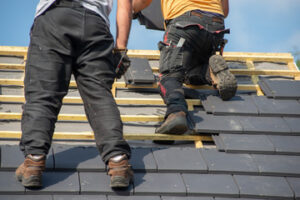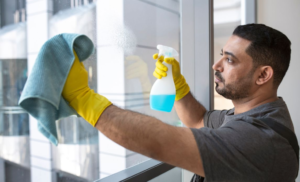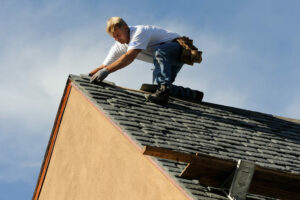A roof protects the walls, floors, and furniture of a home. If it’s not in good condition, water could leak into the house and cause damage. For more information, click the link https://andersonroofingpa.com/ provided to proceed.
There are many roofing options available to homeowners. Among them are shingles, metal, clay or slate tiles, green roofs, and more. Several roofing components include roof decking (sheathing), underlayment, ventilation products, and ridge vents.

Roofing is the outermost layer of a building’s structure, protecting it from rain and sun. Roofing materials vary widely, from natural products like thatch and slate to synthetic membranes. Generally, they are placed on top of a secondary water-resistant material called underlayment. The type of roof framing used to support the roofing materials also varies: double tees are good for 30-foot (9.1 m) spans; t-beams are better for 36-foot (11.1 m) spans; and prestressed joists and planks work well for 60-foot (18 m) or more spans.
There are several different roofing materials to choose from when re-roofing your home. Each of these has its benefits and drawbacks, so you must think carefully about which is best for your home and your climate. Your choice of material will also impact the overall appearance of your roof and, therefore, the resale value of your house.
The oldest roofing materials were woven sticks, straw, mud, and wood lattices. Since the beginning of human settlements, these have been used to protect people and things from rain, snow, and sunlight. Over time, new materials were developed to make these structures more insulated and attractive. These modern roofing materials are often made from several ingredients that provide varying levels of protection and insulation.
Wooden shingles and shakes are made from redwood or cedar and come in various thicknesses, widths, and shapes. They are popular with many homeowners because of their natural beauty and long lifespans. Depending on the maintenance and environmental conditions, they can last up to 30 years in moderate climate zones.
Another common roof material is fiberglass mats doused in asphalt and covered with granules. It is considered a low-cost, simple, and effective roof system. However, it offers any roofing material’s lowest insulation quality and lifespan.
Alternatively, you can have an insulated metal roof installed on your home. This is an excellent way to lower your energy bills and help the environment by reducing carbon emissions. It is important to hire an experienced roofing contractor to install this type of roof to ensure it is done correctly and to the required standards.
Other popular roofing systems are EPDM membranes, TPO roofing, and high-density spray polyurethane foam. These single-membrane systems are often used for flat and low-slope roofs, such as sheds and garages. They are a good option for low-traffic areas because they do not need to be covered with shingles. Nonetheless, they are not recommended for use in living spaces because they tend to absorb heat and can be difficult to maintain.
Roofing is a complex process that requires careful attention to detail. Whether you are a DIYer or are hiring professionals, it is important to understand what goes into a quality roof installation. A well-installed roof will provide protection and energy efficiency and enhance the curb appeal of your home or business for years to come.
A skilled contractor will start the process by obtaining all necessary permits. In addition, they will move all vehicles out of the driveway and garage to prevent damage during the tear-off and installation process.
The next step is to install the underlayment. This layer of felt protects the rest of the roof and helps maintain or increase the fire rating of the structure. The contractor will nail the first row of underlayment close to the edge and farther apart as they go down the roof, overlapping each row.
A roof protects a building against rain, snow, sunlight, wind, and temperature extremes. It can be constructed in various forms, including flat, pitched, vaulted, and domed. It provides aesthetic value and significant value to a home or commercial facility. Proper maintenance procedures help ensure the life and durability of roofing systems.
The most effective maintenance procedure is a scheduled inspection and routine repair by experienced roofing professionals on a biannual basis. This enables problems to be identified and repaired before they become serious and costly. A maintenance checklist tailored to each roof should be prepared.
In addition to roof surface examination, all drains, scuppers, and gutters should be cleaned regularly to reduce the accumulation of debris. Such accumulation restricts drainage, accelerates membrane deterioration, and poses a potential puncture hazard from sharp objects or wind-driven movement.
Any moss or algae growth should be removed promptly to prevent damage to shingle surfaces. Scrubbing the affected areas with a brush and applying a moss-killing solution may be necessary. In addition, a fire retardant felt is recommended to be maintained under the shingles to maintain or improve their Class A fire rating.
The flashing (metal strips that seal gaps between components such as the chimney and vent pipes) should be examined carefully to ensure it is intact. If the metal has rusted, it should be repaired immediately to avoid water damage. The caulking around pipes and vents should also be checked periodically to ensure it is still intact.
Another thing to keep in mind is that wood can be vulnerable to fire if it’s not treated with preservatives and other protective coatings. You can apply these to a wooden roof before it’s installed, but they’ll need to be reapplied over the years as needed.
If you’re a fan of the natural look of wood but want to avoid dealing with the upkeep and vulnerability, you can opt for composite shingles instead. This synthetic material is shaped to look like real wood and comes in a wide range of color options. It’s also a sustainable option as long as it’s recycled from ethically harvested sources. However, it’s important to note that this is less durable than a genuine wood roof and will only last for a while. It’s also not as fire-resistant as a traditional wood roof.
As the name suggests, synthetic roofs are manufactured to mimic the look of natural roofing. Often, they also offer added properties such as impact resistance for locations that experience large hail and uplift resistance in high wind conditions. They can be made of various materials, including recycled polymers, rubbers, clays, plastics, and asphalt. This wide range of materials allows for various aesthetic choices and helps the budget-oriented consumer find a great fit.
Aside from their durability, another reason homeowners are increasingly choosing synthetic shingles is their environmental friendliness. These shingles are produced with recycled material; many are even completely recyclable after use. Additionally, the manufacturers of these shingles often incorporate advanced UV inhibitors that help decrease wear from the sun’s harsh rays.
Many of these shingles are backed by an industry-leading 50-year warranty, which adds further value and peace of mind to the homeowner. They are much lighter than their authentic slate and wood alternatives, making them easier to install. Plus, they don’t require additional reinforcement to the home’s framing like a traditional slate or wood roof.
While it may seem counterintuitive, synthetic shingles are more energy efficient than their natural alternatives. This is because the advanced UV inhibitors in these shingles help reflect the sun’s heat and rays. This reduces the demand for air conditioning systems and decreases the infamous “heat-island” effect experienced in heavily populated areas.
In addition, these shingles’ safety features are unparalleled compared to cedar and slate. Unlike those two popular roofing options, they are Class-A fire-rated, with the highest possible rating for roof materials. That means they are not flammable and resist the spread of fire, providing you with the utmost safety and protection for your family.
If you’re considering a new synthetic roof, we recommend you consult a professional roofer to determine your best option. Our team of experts is ready to guide you through the entire process. To start, schedule your free roofing inspection by clicking the button below!


